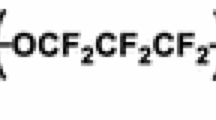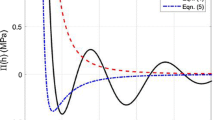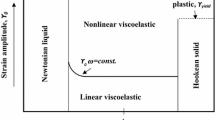Abstract
Interactions among molecularly thin lubricant–solid and lubricant–vapor interfaces become increasingly strong when the slider approaches closer to the disk (or media) surface, which is desirable for higher storage areal densities. Lubricant transfers from the disk to the slider as the head-media spacing decreases below a critical value, leading to loss of protection for the solid thin films. The present work proposes a new criterion for lubricant pickup to occur by improving the lubricant transfer model via considering interactions between the lubricant films, in addition to lubricant–solid interaction. The effect of lubricant roughness is also included in the proposed model, which is then used to predict critical solid distances as a function of lubricant roughness and average lubricant thickness. It is found that the interaction force between the slider solid and the disk lubricant plays a weaker role than that between the lubricant on the slider and the lubricant on the disk in determining the critical solid distance. The physics for the dependence of the critical clearance on the bonding ratio is explained, and a linear model is developed.









Similar content being viewed by others
References
Kim, H.I., Mate, C.M., Hannibal, K.A., Perry, S.S.: How disjoining pressure drives the dewetting of a polymer film on a silicon surface. Phys. Rev. Lett. 82, 3496 (1999)
Waltman, R.J., Deng, H., Wang, G.J., Zhu, H., Tyndall, G.W.: The effect of PFPE film thickness and molecular polarity on the pick-up of disk lubricant by a low-flying slider. Tribol. Lett. 39, 211–219 (2010)
Gao, C., Dai, P., Vu, V.: Flying stiction, lubricant pick-up and carbon overcoat wear of magnetic heads. J. Tribol. 121, 97–101 (1999)
Mate, C.M., Marchon, B., Murthy, A.N., Kim, S.H.: Lubricant-induced spacing increases at slider-disk interfaces in disk drives. Tribol. Lett. 37, 581–590 (2010)
Ma, Y.S., Liu, B.: Lubricant transfer from disk to slider in hard disk drives. Appl. Phys. Lett. 90, 143516 (2007)
Li, N., Meng, Y., Bogy, D.B.: Effects of PFPE lubricant properties on the critical clearance and rate of the lubricant transfer from disk surface to slider. Tribol. Lett. 43, 275–286 (2011)
Pit, R., Marchon, B., Meeks, S., Velidandla, V.: Formation of lubricant “moguls” at the head/disk interface. Tribol. Lett. 10, 133–142 (2001)
Ma, X., Tang, H., Stirniman, M., Gui, J.: Lubricant thickness modulation induced by head-disk dynamic interactions. IEEE Trans. Magn. 38, 112–118 (2002)
Tagawa, N., Andoh, H., Tani, H.: Study on lubrication depletion induced by laser heating in thermally assisted magnetic recording systems: effects of lubricant thickness and bonding ratio. Tribol. Lett. 37, 411–418 (2010)
Stanley, H.M., Etsion, I., Bogy, D.B.: Adhesion of contacting rough surface in the presence of sub-boundary lubrication. J. Tribol. 112, 98–104 (1990)
Suh, A.Y., Polycarpou, A.A.: Adhesive contact modeling for sub-5-nm ultralow flying magnetic storage head-disk interfaces including roughness effects. J. Appl. Phys. 97, 104328 (2005)
Yu, N., Polycarpou, A.A.: Adhesive contact based on the Lennard-Jones potential: a correction to the value of the equilibrium distance as used in the potential. J. Colloid Interface Sci. 278, 428–435 (2004)
Derjaguin, B.V.: Definition of the concept of and magnitude of the disjoining pressure and its role in the statics and kinetics of thin layers of liquid. Colloid J. USSR 17, 191–197 (1955)
Tyndall, G.W., Karis, T.E., Jhon, M.S.: Spreading profiles of molecularly thin perfluoropolyether films. Tribol. Trans. 42(3), 463–470 (1999)
Karis, T.E.: Water adsorption on thin film media. J. Colloid Interface Sci. 225, 196–203 (2000)
Waltman, R.J.: Autophobic dewetting of Z-tetraol perfluoropolyether lubricant films on the amorphous nitrogenated carbon surface. Langmuir 20, 3166–3172 (2004)
He, Y., Fujikawa, Y., Zhang, H., Fukuzawa, K., Mitsuya, Y.: Evaluations of tribological characteristics of PFPE lubricants on DLC surfaces of magnetic disks. Tribol. Lett. 27, 1–11 (2007)
Derjaguin, B.V., Churaev, N.V.: Structural component of disjoining pressure. J. Colloid Interface Sci. 49, 249–255 (1974)
Marchon, B., Pitchford, T., Hsia, Y.T., Gangopadhyay, S.: The head-disk interface roadmap to an areal density of 4 Tbit/in2. Adv. Tribol. doi:10.1155/2013/521086 (2013)
Israelachvili, J.N.: The calculation of van der Waals dispersion forces between macroscopic bodies. Proc. R. Soc. Lond. A 331, 39–55 (1972)
Ambekar, R.P., Bogy, D.B., Dai, Q., Marchon, B.: Critical clearance and lubricant instability at the head-disk interface of a disk drive. Appl. Phys. Lett. 92, 033104 (2008)
Mate, C.M.: Taking a fresh look at disjoining pressure of lubricants at slider-disk interfaces. IEEE Trans. Magn. 47, 124–130 (2011)
Wong, C.H., Li, B., Yu, S.K., Hua, W., Zhou, W.D.: Molecular dynamics simulation of lubricant redistribution and transfer at near-contact head-disk interface. Tribol. Lett. 43, 89–99 (2011)
Mate, C.M., Toney, M.F., Leach, K.A.: Roughness of thin perfluoropolyether lubricant films: influence on disk drive technology. IEEE Trans. Magn. 37, 1821–1823 (2001)
Acknowledgments
The initial funding and motivation of this work was through a sponsored research program from Seagate Technology LLC through Grant No. SRA – 4828. The authors gratefully acknowledge this support.
Author information
Authors and Affiliations
Corresponding author
Appendices
Appendix 1: Derivation of Lube–Lube Interaction Pressure π lube in Eq. 6
Considering the lubricant on the disk, the interaction energy with the lubricant with distance of dz on the slider is given by (Fig. 10)
Assuming the lubricant thickness picked up by the slider is also h, i.e., h p = h, then the equation reduces to
The force per unit area (pressure) for lube–lube interaction is obtained by
Appendix 2: Effects of Bonding Ratio on the Lubricant Transfer, Eq. 8
When the lubricant bonding ratio equals to zero (BR = 0), A LVS plays a very weak role in the determination of the critical clearance, as indicated in Fig. 7, and therefore, the \(\pi_{\text{slider}}\) term in Eq. 4 can be neglected and reduces to:
Also neglecting the attraction from the lubricant itself, namely the second term on the RHS of Eq. 13 reduces to:
Then the critical solid distance can be solved:
To the contrary, when BR is equal to one (BR = 1), there is no mobile lubricant available for transfer, and thus, \(\pi_{\text{Lube}} = 0;\) Eq. 4 reduces to:
which is the form widely used in the literature that ignores lube–lube interaction. The solution for the critical solid distance is:
Rights and permissions
About this article
Cite this article
Zhang, Y., Polycarpou, A.A. Lubricant Transfer Model at the Head-Disk Interface in Magnetic Storage Considering Lubricant–Lubricant Interaction. Tribol Lett 62, 38 (2016). https://doi.org/10.1007/s11249-016-0688-5
Received:
Accepted:
Published:
DOI: https://doi.org/10.1007/s11249-016-0688-5





